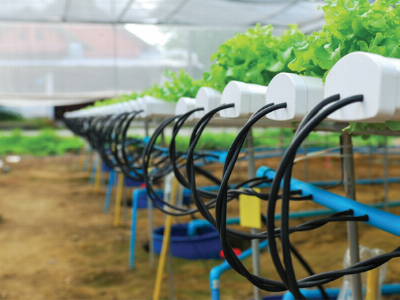The Importance of Oxygen in Hydroponic Systems

It is very common for new hydroponic gardeners to have an over developed focus on the nutrient aspects of their cultures while totally neglecting other very important aspects such as aeration and light. Some of the most common problems that plants face are a direct consequence of a lack of a proper supply of oxygen, issues which could easily be fixed if this factor was taken into account with as much interest as the composition and character of the hydroponic nutrients used. On today’s post I want to talk a little bit about the paramount importance of oxygen, why it is so important and what things you can do to ensure that your hydroponics crops are not starved of this extremely important element.
First of all we need to understand why plants need oxygen. This gas is vital for many living organisms because it performs a very important function within their cells. Oxygen reacts with carbohydrates within any aerobic organism’s organelles to produce ATP, which is the primary chemical used to fuel biochemical processes. Plants need this ATP to perform several functions which require energy, like the absorption of nutrients and the production of aminoacids. Plants need great amounts of oxygen in their roots in such an extent that one of the limiting factors of growth in hydroponics – after light – is oxygen availability to root cells.
A very important thing that you must take into account is how much oxygen your hydroponic system allows roots to have. Static culture systems, like lettuce floating rafts or any system where roots are permanently soaked in water offer little available oxygen since the solubility of oxigen in water is quite low. Even if you aerate the solution constantly using an airpump, the solubility limitation makes the use of such systems to grow large plants – such as tomatoes – extremely difficult.
Larger plants, which have much larger nutrient and energy requirements generally need systems in which the availability of oxygen is not limited. In this case systems where roots are periodically wet and exposed to air have very good results. For example, ebb & flow and drip irrigation systems in which plants are in contact with nutrient solution and with air in an on/off manner guarantee that the large oxygen requirements of energy demanding plants will be fulfilled. In the end, you will see that plants will perform much better when their oxygen and nutrient availability is optimal. For this reason – aeroponic systems – which supply both requirements in an ideal fashion tend to give the best results for most plant types.
In your hydroponic system, ensuring a good supply of oxygen is absolutely vital. You should ensure that your hydroponic system is adequate for the plant you want to grow and you must also check that your system is always giving its maximum oxygenation potential. In static systems you always need to check the frequency and quantity of aerators and on dynamic setups checking cultivation media drainage and irrigation frequency is key to get the best possible results. After taking into account all this you will see that paying close attention to oxygenation will eliminate many of the problems you may have, giving you a much healthier and productive hydroponic crop.
Try Hydroponics Calculator here http://2lua.vn/agritec/hydroponics-calculator.html?hl=en
Related news
 Completely Passive, Non-Recirculating Hydroponic Systems some Tips for Large Plants
Completely Passive, Non-Recirculating Hydroponic Systems some Tips for Large Plants Today I want to share with you some tips to use this type of system with larger plants so that you can effectively setup your own hydroponic passive farm
 Hydroponic Nutrient Availability what “Pushing Out an Element” Really Means
Hydroponic Nutrient Availability what “Pushing Out an Element” Really Means Plants need a very large. In hydroponic crops we intend to provide all these elements in their different forms dissolved within our nutrient solutions
 Planting density of various vegetable crops in hydroponic systems
Planting density of various vegetable crops in hydroponic systems Pepper & tomato planting density influences yields, diseases and quality of the end product. Get it right the first time. Peppers are planted in the same